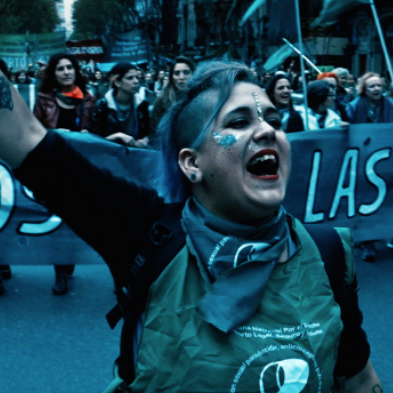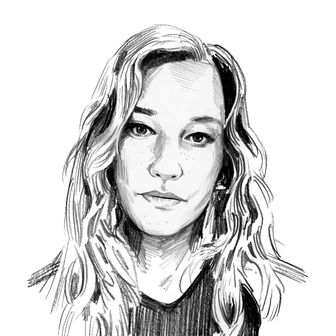
The Cannes Film Festival is an innately surreal experience. One moment you’re smushed between jet-lagged, irritable journalists in an hourlong line for an obscure foreign film; the next, you’re standing on a hotel rooftop, watching two hulking bodyguards smuggle Selena Gomez into a party where actors are dressed as haute-couture zombies. This is my first time here, so I can’t speak to whether it feels less wild (or you feel less undeserving) as the years go by, but I do know that I’ve never experienced as much cognitive dissonance — fever-dream thrills paired with stomach-churning guilt — as I have here. Because, while I’m in France making jokes about Rocketman, back home, the GOP is waging a calculated war on women’s bodies.
Every time I exit a screening, or wake up six hours off key and check my phone, there’s a frightening new development to consider. Alabama’s new law would make performing an abortion at any stage of pregnancy a felony punishable by up to 99 years or life in prison, with no exceptions for rape or incest. Mississippi’s new law seeks to ban most abortions after a fetal heartbeat is detected. Louisiana, South Carolina, and Missouri are close to passing similar heartbeat laws. Far away, I feel helpless, terrified for the people with uteruses living in these states, and sick with worry about the targeted national campaign to take down Roe v. Wade. Which is why it was, in a strange way, cathartic to walk into Que Sea Ley, an Argentine documentary about the long, difficult struggle to legalize abortion in the South American country.
I don’t mean “cathartic” in the traditional sense — Que Sea Ley, which translates to “Let It Be Law,” is a harrowing watch. But as we entered the theater, the audience was greeted by a sea of green bandannas, each draped over a dark red seat. The color represents a woman’s right to a free, safe, and legal abortion in Argentina (those in the anti-abortion movement wear blue bandannas). Moments later, a group of Argentine women dressed in bright green, each holding her own bandanna, entered the theater and began chanting — jumping up and down and cheering in unison. “Que sea ley! Que sea ley!” they sang, smiling and laughing, pumping their fists in the air. (Outside the theater, the likes of Penelope Cruz and Pedro Almódovar were sporting their own green bandannas, too.) The women began leading the audience in the chant as the lights flickered on and off, radiating hope and optimism and strength. I burst into tears, and didn’t stop for the next 90 minutes. Neither did the women to my left and right.
The documentary, from Argentine filmmaker Juan Solanas, begins in early 2018, just as the country’s House passed a measure to legalize abortion, which was, for decades, illegal and punishable by prison time for both women and their doctors, except in rare cases. For a bill to become a law in Argentina, the Senate must also approve the bill; Solanos’s film follows the months of hearings that preceded the Senate vote, where doctors, officers of the church, rape survivors, and politicians alike take the stand to share their take on the debate.
Outside the Senate, the women Solanos speaks to are hopeful — they organize in the streets by the millions, with green glitter smeared across their faces, pounding drums, chanting about defeating the patriarchy and gaining autonomy over their own bodies. They call themselves “militants” and “feminists,” and they span from childhood to old age. The older women regularly express their delight that the younger generation has taken up the cause that, as one woman puts it, “we’ve been fighting for many years.” “We are the granddaughters of witches you couldn’t burn,” sings one group of young women. “This is my body; I decide.”
Interspersed between the hearings and the joyful shots of women protesting, Solanos reminds us why this fight matters so much. He connects larger issues of social and economic inequality with illegal abortion, demonstrating how it unduly affects the poor and the vulnerable, how it’s part of a larger campaign to control women’s bodies and lives. Statistics about women in Argentina flash across the screen in giant white letters: One woman dies owing to a clandestine abortion; 18 percent of pregnancies are child pregnancies; every three hours, a teenager gives birth in Argentina, and 70 percent of these births are unwanted; 33 percent of Argentines live in poverty; 48 percent are minors; every 26 hours, a woman in Argentina is killed. Priests, gynecologists, and senators talk directly to Solanos’s camera, express their urgent desire for the law to pass: “We can’t impose our personal beliefs onto society,” says one senator. “Jesus would not want women in jail for having an abortion,” says one priest.
But the most affecting moments come from women who’ve survived clandestine abortions and tell their horrifying stories — and, most devastatingly, from the families of women who haven’t survived, telling the stories of their lost loved ones. One woman shares how she became an activist after reading about a girl who bled to death in a rented room after trying to give herself an abortion with a knitting needle. Another tells the story of her sister, who called her, bleeding, from the “slums,” where she’d just had a clandestine abortion; when she rushed her sister to the hospital, the doctors found parsley stuffed in her womb.
Ana Maria Acevedo, one of the faces of the pro-choice movement, was a 19-year-old woman with three young children who was two weeks pregnant when she was diagnosed with cancer. The doctors refused to treat her, instead waiting for her to carry the baby to term. Acevedo and her family begged the doctors for a therapeutic abortion, but they refused, and though they kept promising to meet with a “judge and a priest” to discuss the matter, they never did. Acevedo, near death, had a C-section at 22 weeks, and the baby died shortly thereafter. Soon, so did Acevedo. “My daughter was killed,” Acevedo’s bereft mother tells Solanos. “They destroyed her. How do we explain this to her children?”
Liliana Herrera, another face of the movement, was a mother of two who had a clandestine abortion because she couldn’t afford another child. She quickly developed a horrible infection. Her family had no car, so they asked a friend to take her to the hospital, and met her there. They weren’t allowed in the room. The doctors left her, screaming in pain, overnight, and didn’t operate on her until the next day. She died. Her sister died from a clandestine abortion, too. Now her parents are raising Herrera’s children. Solanos shows them onscreen: two sweet, adorable young girls wearing leggings and munching on watermelon, smiling at the camera. One wears a shirt that reads “Love, Love, Love.” As Herrera’s parents tell the story, her father can barely speak, choking back tears.
There’s also Belen, who went to the hospital with a bad stomach ache not knowing she was pregnant, and miscarried. She was charged with homicide and is now in jail. And Lu, who was raped by her mother’s boyfriend at age 12. Her mother blamed her, and forced her to keep the baby, causing Lu to seek the dangerous services of an “old woman healer” who nearly killed her. Lu says she “didn’t care if I died” during the procedure. “If I hadn’t [had the abortion],” says Lu, “I would have killed myself.” And Florencia, a survivor, who says a clandestine abortionist gave her pills to put inside of her body. When she woke up, she couldn’t feel her legs, so she went to the hospital, where doctors mocked and verbally abused her. Cecila, a gynecologist, tells Solanos through tears that she used to be one of those doctors, until she realized what she was doing was “wrong.” “I watched dozens of women die surrounded by policeman asking them who gave them the abortion, so they could arrest them,” she says. “They took the secrets to their tomb while being judged, stigmatized, and mistreated.”
Solanos spends some time with the anti-abortion movement, as well — at a large rally with a gigantic papier-mâché baby floating through the air, a speaker begs for forgiveness for women “murdering babies.” A man yells at a female newscaster, arguing that a 10-year-old could become pregnant and it wouldn’t necessarily be rape. “She wanted to sleep with her grandmother’s partner?” asks the newscaster, incredulous. “Maybe,” he says. Later, the movement proudly displays a photo of a 12-year-old with a baby during the Senate hearings, supposed proof of triumph.
In the film’s second to last scene, millions of women crowd the streets of Argentina, waiting for the Senate’s verdict. It’s another sea of green, with women dancing and beating drums, waiting to celebrate the monumental moment. It begins to rain, but they don’t let up. They gather to watch the verdict projected onto a gigantic screen, gripping each other in excitement. A senator announces that the vote is “negative,” with 31 senators in favor, and 38 against. In the end, it came down to seven votes. The women begin to sob, turning to hug each other. But one of them hops on the microphone: “We made history today, and the Senate didn’t listen,” she says. “We are a wave that can’t be stopped.”
“Ana Maria Acevedo?” she asks the crowd, who begin to reanimate. “Present!” they yell. They resume their chanting.
The film ends with Solanos revisiting each of his subjects. “Que sea ley,” they say, one at a time, smiling directly into the camera. “Let it be law.” In Cannes, as the screening ended, and the lights went up, the Argentine women — the militants from the film — stood again, many of them crying. They held their green bandannas taut over their heads. The entire theater stood and applauded for several minutes. Then the audience started chanting along with the women: “Que sea ley! Que sea ley!”





